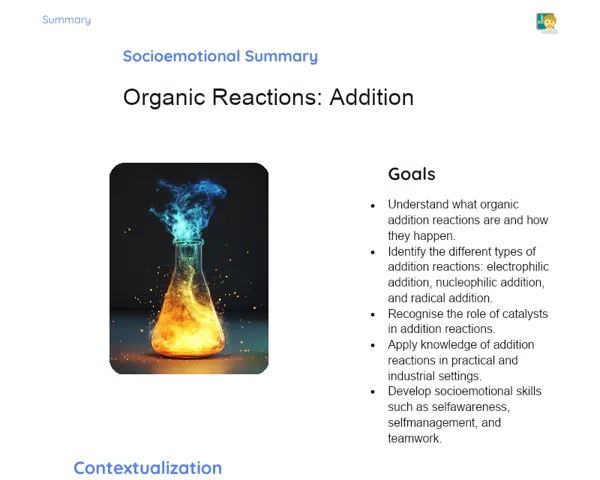Socioemotional Summary Conclusion
Goals
1. Accurately name acids using IUPAC nomenclature.
2. Apply knowledge to solve problems related to the naming of acids.
Contextualization
Did you know that many everyday products contain acids? From the vinegar we splash on our salads to sulfuric acid in car batteries, understanding how to name these acids helps us to appreciate and navigate the world around us better. Let’s dive into this captivating realm of chemistry together and discover how these acids are named!
Exercising Your Knowledge
Introduction to Acids
Acids are substances that release H+ (hydrogen) ions when dissolved in water. These compounds have distinct properties, such as a sour taste, the ability to corrode metals, and their reactions with bases to form salts. Studying acids is crucial for grasping various natural and industrial processes. Additionally, the chemistry of acids is linked to our day-to-day lives, from lemon juice to common cleaning supplies.
-
Release of H+ ions: In water, acids break down to release hydrogen ions, which is key in defining a solution's acidity.
-
Chemical Properties: Acids typically taste sour, can corrode certain metals, and react with bases to form salts and water – this is known as neutralization.
-
Importance in Everyday Life: Acids are commonly found in various products we use every day, such as food (acetic acid in vinegar) and cleaning agents (hydrochloric acid).
Classification of Acids
Acids can be classified into organic and inorganic types. In this lesson, we’ll focus on inorganic acids, which are mainly composed of hydrogen combined with either nonmetals or oxygen. Understanding this classification is vital for knowing their properties and uses, as well as for properly naming them in line with IUPAC standards.
-
Binary Acids: Made up of hydrogen and a nonmetal, examples include HCl (hydrochloric acid) and HBr (hydrobromic acid). They are named following the structure 'acid + name of the nonmetal + ic'.
-
Oxyacids: Composed of hydrogen, oxygen, and a nonmetal. For instance, H2SO4 is sulfuric acid. The naming depends on the number of oxygen atoms and may vary between 'ic' and 'ous'.
-
Importance of Classification: Classifying acids allows us to anticipate their chemical behaviour and possible reactions, enhancing our comprehension and enabling safe usage.
Acid Nomenclature According to IUPAC
IUPAC nomenclature (International Union of Pure and Applied Chemistry) provides a universal system to name chemical compounds with precision. For acids, this system allows us to clearly identify their structures and properties, reducing confusion and aiding scientific communication.
-
Binary Acids: Named as 'acid + name of the nonmetal + ic'. For example, HCl is known as hydrochloric acid.
-
Oxyacids: Their names depend on the number of oxygen atoms, employing suffixes like 'ic' (more oxygens) and 'ous' (fewer oxygens). For example, H2SO4 is sulfuric acid, while H2SO3 is sulfurous acid.
-
Importance of Nomenclature: This standardized naming system is vital for avoiding misunderstandings and ensuring everyone knows exactly which substance is being discussed, an essential consideration in both academic and industrial settings.
Key Terms
-
Binary Acid: An acid made up of hydrogen and a nonmetal.
-
Oxyacid: An acid composed of hydrogen, oxygen, and a nonmetal.
-
IUPAC Nomenclature: A standardized naming system for chemical compounds by the International Union of Pure and Applied Chemistry.
For Reflection
-
How can grasping the nomenclature of acids help us make safer and more informed choices in our daily lives?
-
In what ways could our understanding of acids and their classifications shift our perspective on the products we use regularly?
-
How can learning about the chemistry of acids enhance our awareness and responsibility when handling chemical substances in our surroundings?
Important Conclusions
-
Acids are fundamental elements in both nature and various industries, with unique properties such as releasing H+ ions, having a sour taste, and the ability to corrode metals.
-
The IUPAC naming system for acids, whether binary or oxyacids, is crucial in preventing misunderstandings and ensuring precise communication in chemical disciplines.
-
An understanding of the classification and naming of acids allows for deeper insight into their behaviours and applications in our daily lives, ranging from foods to cleaning products.
Impacts on Society
Acids are integral to many sectors, including food, pharmaceuticals, and materials. Knowing how to correctly name and identify these compounds enables us to use these chemical products safely and efficiently. For instance, by being aware that hydrochloric acid is found in certain cleaning agents, we can use them more cautiously, reducing the risk of accidents and advocating for safety at home.
Moreover, the chemistry of acids is intrinsically linked to technological and scientific advancements. Advances in chemical research can lead to innovative medicines, the creation of more durable materials, and improvements in industrial processes, all of which have a direct impact on our quality of life and societal advancement. Understanding these concepts not only makes us more knowledgeable but also empowers us to devise thoughtful solutions to upcoming challenges.
Dealing with Emotions
As a home exercise, try using the RULER method while studying acids. First, Recognize any feelings that come up when tackling challenges or achieving successes. Then, Understand why you’re feeling this way — it could stem from the difficulty of the material or the excitement of accomplishment. Label these feelings accurately: anxiety, frustration, satisfaction. While studying, Express your emotions constructively, whether it’s discussing with peers or writing about your thoughts. Finally, Regulate your feelings: if you're feeling overwhelmed, take a breather; if you’re feeling good, celebrate your success! This approach will assist you in maintaining emotional balance during your studies.
Study Tips
-
Create mind maps linking acid nomenclature to their properties and applications. This helps make memorization easier and clarifies relationships between various concepts.
-
Regularly practice naming exercises using online resources or formula lists. Repetition is essential for solidifying knowledge!
-
Study in groups and converse with classmates about concepts. Working together can make learning more engaging and help clarify any uncertainties.



